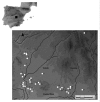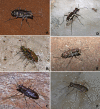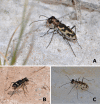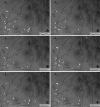Salt lakes of La Mancha (Central Spain): A hot spot for tiger beetle (Carabidae, Cicindelinae) species diversity
- PMID: 27006617
- PMCID: PMC4768367
- DOI: 10.3897/zookeys.561.6042
Salt lakes of La Mancha (Central Spain): A hot spot for tiger beetle (Carabidae, Cicindelinae) species diversity
Abstract
The tiger beetle assemblage of the wetlands of La Mancha (central Spain) comprises nine species: Calomera littoralis littoralis, Cephalota maura maura, Cephalota circumdata imperialis, Cephalota dulcinea, Cicindela campestris campestris, Cicindela maroccana, Cylindera paludosa, Lophyra flexuosa flexuosa, and Myriochila melancholica melancholica. This assemblage represents the largest concentration of tiger beetles in a single 1º latitude / longitude square in Europe. General patterns of spatial and temporal segregation among species are discussed based on observations of 1462 specimens registered during an observation period of one year, from April to August. The different species of Cicindelini appear to be distributed over space and time, with little overlapping among them. Three sets of species replace each other phenologically as the season goes on. Most of the species occupy drying or dried salt lakes and salt marshes, with sparse vegetation cover. Spatial segregation is marked in terms of substrate and vegetation use. Calomera littoralis and Myriochila melancholica have been observed mainly on wet soils; Cephalota circumdata on dry open saline flats; Cephalota dulcinea and Cylindera paludosa in granulated substrates with typical halophytic vegetation; Cephalota maura is often present in man-modified areas. Cephalota circumdata and Cephalota dulcinea are included as species of special interest in the list of protected species in Castilla-La Mancha. Conservation problems for the Cicindelini assemblage arise from agricultural activities and inadequate use of sport vehicles. Attempts at restoring the original habitat, supressing old semi-industrial structures, may affect the spatial heterogeneity of the lakes, and have an effect on Cicindelinae diversity.
Keywords: Behaviour; Coleoptera; Conservation; Habitat selection; Lakes; Phenology; Salt marshes.
Figures














References
-
- Alonso M. (1998) Las lagunas de la España peninsular. Limnetica 15: 1–176.
-
- Acciavatti RE, Pearson DL. (1989) The tiger beetles Cicindela (Coleoptera, Insecta) from the Indian subcontinent. Annals of the Carnegie Museum 58: 77–354.
-
- Aguirre E, Del Río A, Espiñeira J, Fernández-González F. (2013) Conclusiones del encuentro internacional de expertos en humedales y estepas salinas. 25, 26 y 27 de septiembre, Toledo, España Fundación Global Nature, 32 pp.
-
- Albert EM, Zardoya R, García-París M. (2007) Phylogeographic and speciation patterns in subterranean worm lizards of the genus Blanus (Amphisbaenia: Blanidae). Molecular Ecology 16: 1519–1531. doi: 10.1111/j.1365-294X.2007.03248.x - DOI - PubMed
-
- Aliquò V. (1992) La collezione entomologica Alliata del Museo Regionale di Terrasini. Coleoptera: 1. Cicindelidae; 2. Tenebrionidae. Naturalista siciliano 16: 13–28.
LinkOut - more resources
Full Text Sources
Other Literature Sources
Miscellaneous
